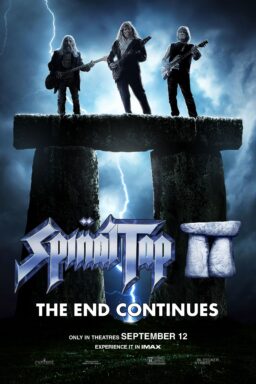1.
“Joost van Ginkel on ‘170 Hz,’ ‘The Paradise Suite’“: The acclaimed Dutch filmmaker chats with me at Indie Outlook about his two remarkable features, which have yet to acquire U.S. distribution.
“One of my inspirations for the film occurred when I was living in Amsterdam. I was cycling home in the middle of the night, and I spotted a large group of people on the opposite side of the street. As I got closer to them, I noticed that I couldn’t hear any of their voices. Then I realized that the group was comprised of about 50 deaf-mute teenagers who were shouting at each other with their hands. I was really grabbed by that, and I decided that if I was going to make a feature, it would be in sign language. As I learned more about the deaf-mute community, I found that all people are more or less the same. You and I experience the same emotions as people from Japan or Namibia or Canada. I never saw sign language as the subject of this film. I looked at it from an artistic perspective. Some people told me that the film should be about the problems facing the Deaf community, but after meeting so many deaf-mute people, I found them to be as happy as people with no hearing impairment. Their language is one of the most beautiful in existence, apart from Russian and Italian. At the same time, I was making an experimental television show with a well-known stand-up comedian, and the production office was located in a harbor next to a Russian submarine. Suddenly, the premise for ‘170 Hz’ started to come together: a Romeo and Juliet story about deaf-mute kids who seek their freedom by hiding together in a submarine.”
2.

“How Movies Handle Bipolar Disorder“: Keyframe‘s Sara Freeman provides an in-depth analysis of how bipolar disorder is portrayed in cinema.
“Most movies about mental illness reaffirm societal notions about how burdensome it is to people who don’t have it. For example, this year’s lovely ‘A Light Beneath Their Feet,’ starring Taryn Manning and Madison Davenport, gives an honest, insightful look into what it’s like to live up close and personal with someone who has bipolar disorder. Manning and Davenport play an inseparable mother and daughter constantly battling the everyday realities of the mother’s illness, from getting her to take her medication to holding down a job. Manning’s character is very attached to her daughter, who has her choice of colleges, but also wants her to stay close by as a caregiver. Naturally the girl feels stifled by her mother’s illness and clinginess, and wants more than anything to just get away and be a “normal” person. ‘A Light Beneath Their Feet’ goes to great lengths to show that maintaining a good relationship with someone who’s mentally ill is possible, if hardly easy, with mutual honesty and openness. And of course everything is harder for women. Though no one in the movie ever says so explicitly, it’s fairly clear that Gena Rowlands’ character has a variant of bipolar disorder or schizophrenia in ‘A Woman Under the Influence’ (1974). Like ‘Splendor in the Grass’ (1961) before it, ‘A Woman Under the Influence’ shows the painful reality of what it means to be a mentally ill woman, and the hysteria we’re often driven to when we don’t fit into society’s nicely designed roles for us.”
3.

“‘The Birth of a Nation’ Isn’t Worth Defending“: According to The New Yorker‘s Vinson Cunningham.
“I first saw ‘The Birth of a Nation’ in April, at the News Corp headquarters in New York. As I waited for it to begin, I heard someone sigh loudly and say, ‘You know, I almost don’t want to see this now. When you know something’s gonna be so good—and so important—you kind of wanna wait.’ That word, ‘important’—along with its cousins ‘powerful’ and ‘necessary’—had figured in the first reviews of the film. Even critics who expressed a slight ambivalence about the movie’s artistic merits had chased those worries away by reminding readers how important it was to have Nat Turner’s story finally presented on an epic scale. Given the chronic exclusion of blacks in entertainment, it’s easy to understand the prevailing critical view that a work of art by a black artist about the bleakest episode in our history must, on these grounds alone, be worthy of our attention. It is true that artistic reimaginings of historical events can prompt us to learn whatever lessons they may contain. Even a bad work of art like ‘Uncle Tom’s Cabin’ went some distance toward helping our country face the magnitude of its sins. But ‘Uncle Tom’s Cabin’ was written, by a white woman, as unabashed propaganda. And if we are to judge ‘The Birth of a Nation’ on these terms—as agitprop, however auteurist—it’s worth asking what greater good, exactly, it might achieve.”
4.

“Hollywood’s most ageist casting decisions—from witches to ‘impossible’ moms“: A fine list compiled by The Guardian‘s Chitra Ramaswamy.
“How to combat the age-old problem of ageism in Hollywood? More female directors? Less of a gender pay gap? A special taskforce led by Meryl Streep, Helen Mirren and Jennifer Lawrence to persuade the industry that there is more to womanhood after 40 than being a grandmother or a witch? It appears the answer is a landmark law, effective from next year in California only, that permits actors to request the removal of their age from professional entertainment sites such as IMDb. Which, you might say, compounds rather than solves the problem by encouraging actors to hide their age if they want more work. But never mind. In a world in which Susan Sarandon is old enough to be Melissa McCarthy’s grandmother (Tammy) and an unwritten law states that Harrison Ford can only snog women at least 15 years younger than him, here are five of the most offensive/unbelievable/disturbing/gross examples of Hollywood ageism.”
5.

“How Long Until a Robot Wins a Pulitzer?“: Unsettling commentary from Literary Hub‘s Abi Inman.
“In The Uses of Literature, Italo Calvino examines the process of writing and explores the role of robots in literature. He brings up the concept of information theory, or how many organic and seemingly unquantifiable things can be boiled down (or built up) to an algorithm. Calvino points out that ‘electronic brains, even if they are still far from producing all the functions of the human brain, are nonetheless capable of providing us with a convincing theoretical model for the most complex processes of our memory, our mental associations, our imagination, our conscience.’ And this was in 1967. Artificial intelligence and natural language processing have taken huge strides since then, and Moore’s law would predict this will only accelerate.As long as we’ve been imagining robots we’ve been imagining the ways they could turn on us, from violent scenarios like the rebellion in ‘I, Robot,’ to ‘Charlie and the Chocolate Factory,’ when Mr. Bucket loses his job at the toothpaste factory to a robot that can screw the caps on faster. For now, unless your writing skills only amount to the literary equivalent of screwing caps onto toothpaste tubes, you’re probably going to be okay—but it’s a natural fear.”
Image of the Day

Benedict Cumberbatch chats with Tom Hiddleston at Interview Magazine.
Video of the Day
Andrés Borja presents a sublimely edited montage of every Oscar winner for Best Picture from 1927 through 2015.












